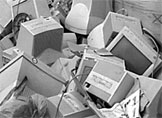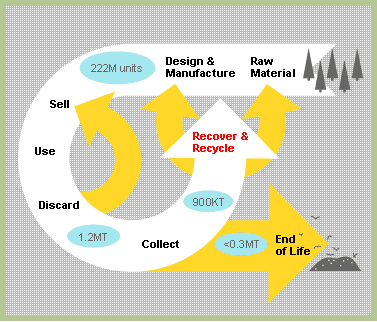|
||||||||||||||||||||||||||||||||
|
|
||||||||||||||||
The WEEE Directive |
|||
It sets mandatory collection targets equal to 65% of the average weight of electrical and electronic equipment placed on the market over the two previous years in each Member State. The recycling and recovery targets of such equipment would cover the re-use of whole appliances and weight-base targets would increase by 5%. Targets are proposed also for the recovery of medical devices. Consumption of EEE / waste arisings World-wide, the growth rates for the electronics industry in 2012 was 9% higher than in 2011 and in 2010 , suggesting that the personal EF for electronics, albeit very small, will also have increased as people own more and increasingly complex EEE. This also means a higher amount of WEEE. The objective of the EU legislation on the Restriction of Hazardous Substances in Electrical and Electronic Equipment (RoHS) and of WEEE (introduced into UK law in 2007) is to increase the recycling and/or re-use of such products (kick-starting a circular economy for these, see below) and require the substitution of heavy metals such as lead, mercury, cadmium, and hexavalent chromium and flame retardants (i.e. polybrominated biphenyls (PBB) or polybrominated diphenyl ethers (PBDE) with safer alternatives. Despite these rules only one third of electrical and electronic waste in the EU is currently reported as separately collected and appropriately treated. The remainder is still likely to end up in landfill and improper treatment outside the EU and illegal trade of WEEE to non-EU countries is still being found at EU borders. The present collection target of 4kg per person and year does not reflect the actual amount of WEEE occurring in the EU. From 2016, the minimum collection targets have been set at 45% increasing to 65% by 2019 .
|
|||
| WHAT'S YOUR FOOTPRINT? | ||||
| CLICK HERE to calculate how much "nature" your mobile phone and personal computer require » | ||||
 |
||||
| FURTHER INFORMATION | ||
|
For more help, contact Giraffe Innovation www.giraffeinnovation.com The WEEE Directive Download pdf RoHS Directive Download pdf BIS - WEEE directve web pages www.bis.gov.uk Envirowise offer a FREE design track service to SMEs www.envirowise.org.uk Industry Council for Electronic Equipment Recycling (ICER) www.icer.org.uk |
||
|
FREQUENTLY ASKED QUESTIONS |
||
 |
THE WEEE DIRECTIVE AT A GLANCEThe WEEE Directive will affect virtually all producers and manufacturers of electrical and electronic equipment. It will make producers responsible for financing the collection of their products at end-of-life, and for meeting targets for reuse, recycling and recovery under 10 broad categories. This section also outlines the RoHS Directive.Read more » |
 |
THE WEEE DIRECTIVE IN DETAILTake a more detailed look at the WEEE and RoHS directives. Investigate why these directives were developed and the anticipated impact on the British economy. Also view information on further proposed legislation, such as the EuP Directive.Read more » |
| BACK TO TOP |
|
||||||||||
